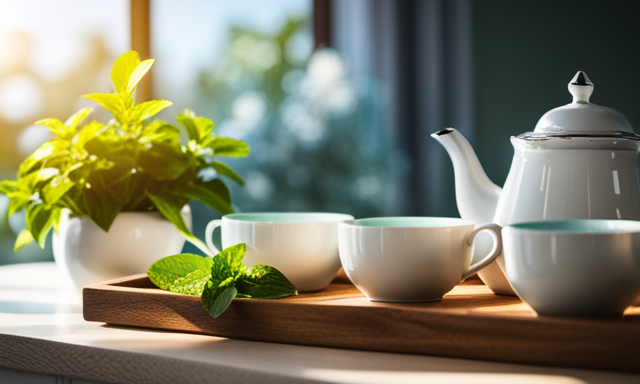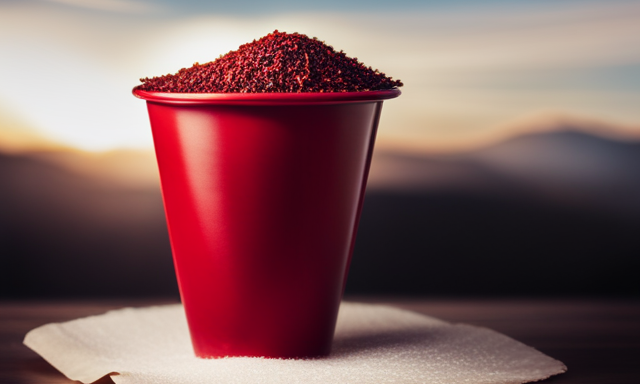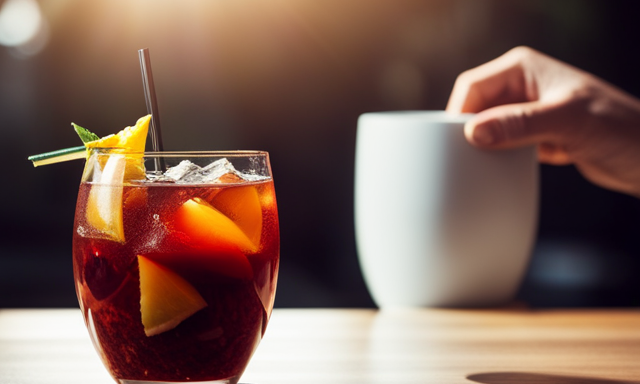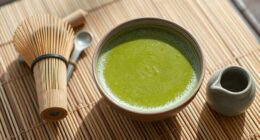Sipping on a steaming cup of rooibos tea on a serene Sunday morning is my idea of pure bliss. The soothing, earthy flavor and the delicate aroma of this South African herbal infusion never fail to transport me to a state of tranquility. But here’s the thing – to truly unlock the full potential of rooibos tea, you need to pay attention to one crucial detail: the water temperature.
Yes, my fellow tea enthusiasts, the temperature at which you brew your rooibos tea can make all the difference between a mediocre cup and a mind-blowingly delicious one. In this article, I will guide you through the art of brewing rooibos tea at the perfect temperature, ensuring that every sip you take is a symphony of flavors dancing on your taste buds.
So, grab your favorite mug and let’s embark on this flavorful journey together.
Key Takeaways
- The ideal brewing temperature for rooibos tea is around 208°F (98°C).
- Using freshly boiled water at this temperature helps extract maximum flavor from the tea leaves.
- Steeping the tea for 5-7 minutes allows for a rich and aromatic cup.
- Using a thermometer can ensure accuracy and help achieve the perfect brewing temperature for optimal taste.
Introduction to Rooibos Tea
If you’re new to the world of Rooibos tea, you’re in for a delightful and caffeine-free treat! Rooibos tea, also known as red bush tea, is a herbal infusion that originates from South Africa. It has gained popularity worldwide due to its unique flavor and numerous health benefits.
Unlike traditional teas, Rooibos tea is naturally caffeine-free, making it a great choice for those looking for a soothing beverage without the jitters. Additionally, Rooibos tea is packed with antioxidants and minerals, such as vitamin C and magnesium, which can support a healthy immune system and promote overall well-being.
Understanding the flavor profile of Rooibos tea is essential in order to brew it at the perfect temperature and extract its full potential.
Understanding the Flavor Profile of Rooibos Tea
Understanding the flavor profile of rooibos tea allows for a richer and more satisfying brewing experience. Rooibos tea offers a delightful combination of sweetness, earthiness, and hints of nuttiness. Its smooth and mellow taste makes it a perfect choice for those seeking a caffeine-free alternative.
To fully appreciate the unique flavors of rooibos tea, it is important to use the right brewing techniques. Here are four key points to consider:
-
Steep time: Longer steeping times, around 5-7 minutes, bring out the full flavor of rooibos tea.
-
Water temperature: Use boiling water, around 100°C (212°F), to extract the maximum flavor from the tea leaves.
-
Tea to water ratio: For a stronger flavor, use one teaspoon of rooibos tea per cup of water.
-
Experiment with additives: Rooibos tea pairs well with honey, lemon, or a splash of milk for added creaminess.
Understanding the flavor profile and brewing techniques of rooibos tea sets the stage for the next section on the importance of water temperature in brewing.
Importance of Water Temperature in Brewing Rooibos Tea
Mastering the art of brewing rooibos tea requires careful attention to the optimal water temperature. The water temperature plays a crucial role in extracting the delicate flavors and aromas of the tea leaves.
For rooibos tea, it is recommended to use water that is just below boiling point, around 200°F (93°C). This temperature allows the tea leaves to release their full potential without extracting any bitter or astringent notes.
Too hot of water can result in a harsh and overpowering brew, while water that is too cool may not fully extract the flavors. By maintaining the appropriate water temperature, you can ensure a perfectly balanced and enjoyable cup of rooibos tea.
Now that we understand the importance of water temperature in the brewing process, let’s move on to preparing your tea leaves or tea bags.
Preparing Your Tea Leaves or Tea Bags
To get your tea leaves or tea bags ready, simply steep them in the perfectly heated water, allowing the flavors to bloom and transport you to a world of pure relaxation and indulgence. Preparing techniques and steeping guidelines are crucial to ensure a delicious cup of rooibos tea. Whether you prefer loose tea leaves or convenient tea bags, the right preparation will enhance the taste and aroma of your brew. For loose tea leaves, use a tea infuser or a strainer to prevent any residue in your cup. If you’re using tea bags, place one bag per cup and let it steep for 5-7 minutes. Remember, the water temperature should be around 203°F (95°C) to extract the full flavor. Once steeped, gently remove the tea leaves or tea bag and savor the exquisite taste. Now, let’s explore the next step in choosing the right brewing method.
Choosing the Right Brewing Method
Explore different brewing methods to find the one that perfectly suits your preferences and allows you to unlock the full potential of your tea leaves or tea bags. When it comes to brewing rooibos tea, there are a few techniques you can try. Here are three popular methods:
-
Traditional steeping: Simply pour hot water over your tea leaves or tea bags and let them steep for a few minutes. This method is quick and easy, but be careful not to oversteep, as it can result in a bitter taste.
-
Cold brewing: This method involves steeping your tea leaves or tea bags in cold water for an extended period, usually overnight. The result is a smooth and refreshing tea with less bitterness.
-
Using tea accessories: Consider using a tea infuser or a teapot with a built-in strainer. These accessories can help enhance the flavor and make the brewing process more convenient.
Now that you know about different brewing techniques and tea accessories, let’s move on to the next step: steeping time for rooibos tea.
Steeping Time for Rooibos Tea
If you want to unlock the full potential of your rooibos tea, timing is everything. When it comes to steeping techniques for rooibos tea, finding the optimal brewing time is crucial. The right amount of time allows the flavors and aromas to fully develop, resulting in a rich and satisfying cup of tea. To help you achieve the perfect brew, here is a table outlining different steeping times for various types of rooibos tea:
| Type of Rooibos Tea | Steeping Time |
|---|---|
| Green Rooibos | 3-5 minutes |
| Red Rooibos | 5-7 minutes |
| Honeybush | 7-10 minutes |
By following these guidelines, you can ensure that you extract the best flavors from your rooibos tea. In the next section, we will explore techniques for enhancing the flavor of rooibos tea without compromising its natural goodness.
Enhancing the Flavor of Rooibos Tea
When it comes to enhancing the flavor of Rooibos tea, there are a few key points to consider.
First, adding sweeteners or milk can provide a creamy and sweet taste to balance out the natural earthiness of the tea.
Second, experimenting with citrus or herbal infusions can add a refreshing and aromatic twist to the flavor profile.
Lastly, it’s important to note that these additions should be done in moderation, as Rooibos tea already has a unique and delicate taste that can easily be overwhelmed.
Adding Sweeteners or Milk
To enhance the rich and earthy flavors of rooibos tea, you can indulge in the velvety sweetness of honey or the creamy indulgence of milk. Adding a sweetener like honey not only adds a touch of sweetness but also complements the natural flavors of rooibos tea. Similarly, adding a splash of milk can give the tea a smoother and creamier texture, balancing out any bitterness. If you prefer a dairy-free option, there are various milk alternatives available, such as almond milk or coconut milk, that can add a hint of nuttiness or tropical flavor to your rooibos tea. To help you choose the perfect sweetener or milk alternative for your taste, refer to the table below:
| Sweetener Options | Milk Alternatives |
|---|---|
| Honey | Almond Milk |
| Maple Syrup | Coconut Milk |
| Agave Nectar | Oat Milk |
| Stevia | Soy Milk |
| Brown Sugar | Rice Milk |
Now that you have explored the sweetener options and milk alternatives, let’s move on to experimenting with citrus or herbal infusions to further enhance the flavors of your rooibos tea.
Experimenting with Citrus or Herbal Infusions
Enhancing the flavors of your rooibos tea can be achieved by experimenting with citrus or herbal infusions, adding a refreshing twist to your cup. Here are three ways you can incorporate citrus or herbal flavors into your rooibos tea:
-
Citrus Experimentation: Squeeze a slice of lemon or orange into your brewed rooibos tea to infuse it with a tangy and zesty taste. The citrus notes complement the natural sweetness of rooibos, creating a vibrant and invigorating blend.
-
Herbal Infusion: Adding herbs like mint, chamomile, or lavender to your rooibos tea can introduce new layers of flavor. These herbs impart their unique aromas and tastes, elevating the overall tea experience.
-
Tea Blending: Blend your rooibos tea with other citrus or herbal teas like green tea or hibiscus for a fusion of flavors. This blend can create a well-rounded and complex taste profile, perfect for those seeking a more adventurous tea experience.
Now, let’s move on to recommendations for serving rooibos tea, where we’ll explore the best brewing techniques and serving suggestions.
Recommendations for Serving Rooibos Tea
When it comes to serving rooibos tea, there are a few key points to consider.
First, you’ll need to decide whether you want to serve it hot or iced. Hot rooibos tea is comforting and soothing, perfect for a cozy afternoon.
On the other hand, iced rooibos tea is refreshing and invigorating, making it a great choice for hot summer days.
Additionally, you can enhance the experience by pairing rooibos tea with different foods. Its naturally sweet and earthy flavor complements a variety of dishes, from chocolate desserts to grilled meats.
Experimenting with different pairings can elevate your tea-drinking experience to a whole new level.
Hot or Iced
Brewing rooibos tea hot or iced depends on personal preference and the temperature that complements the tea’s unique flavors.
When it comes to hot brewing, the ideal temperature for rooibos tea is around 200°F (93°C). This allows the tea to steep properly and release its full flavor. Drinking rooibos tea hot has its own benefits, such as soothing the body, aiding digestion, and promoting relaxation.
However, if you prefer a refreshing and cool beverage, iced rooibos tea is a great option. To make a delicious iced version, brew the tea using hot water, then pour it over ice and garnish with lemon or mint. It’s a perfect choice for hot summer days or as a thirst-quencher.
Now, let’s move on to the next section about pairing rooibos tea with food.
Pairing with Food
To truly savor the robust flavors of rooibos tea, it’s like a culinary journey where each sip dances harmoniously with the perfect bite. Pairing this exquisite tea with the right food can enhance its flavors and create a delightful experience. Here are some pairing suggestions and flavor combinations to elevate your rooibos tea experience:
| Food | Flavor Combinations |
|---|---|
| Dark chocolate | Rich and earthy |
| Citrus fruits | Tangy and refreshing |
| Spicy foods | Warm and invigorating |
These combinations bring out the unique qualities of rooibos tea, creating a symphony of tastes on your palate. Now that you know how to complement your tea, let’s explore the best way to store rooibos tea properly. It’s essential to preserve its freshness and flavor for the ultimate tea-drinking experience.
Storing Rooibos Tea Properly
When it comes to storing Rooibos tea properly, there are two key points to keep in mind: avoiding moisture and light, and extending its shelf life.
To maintain the quality and flavor of Rooibos tea, it is important to store it in an airtight container in a cool, dark place. This helps prevent moisture and light from degrading the tea leaves and compromising its taste.
Additionally, by following proper storage practices, you can extend the shelf life of Rooibos tea and enjoy its delightful flavors for a longer period of time.
Avoiding Moisture and Light
To preserve the delicate flavors and aromatic qualities of your rooibos tea, it is important to keep it away from moisture and light. Here are some tips to avoid oxidation and maintain freshness:
- Store your rooibos tea in an airtight container to prevent exposure to moisture.
- Keep the container in a cool and dark place, such as a pantry or cupboard, away from direct sunlight.
- Avoid storing rooibos tea near strong-smelling substances, as it can easily absorb odors.
By following these precautions, you can ensure that your rooibos tea remains in optimal condition for longer periods. This will allow you to fully enjoy its rich taste and health benefits. Now, let’s move on to the next section where we discuss how to extend the shelf life of rooibos tea.
Extending Shelf Life
Preserving the quality of your rooibos tea is crucial. One interesting statistic to note is that storing it in an airtight container can extend its shelf life by up to six months.
This is because an airtight container prevents moisture and air from entering, which can lead to oxidation and degradation of the tea leaves. Oxidation is the process that causes the tea leaves to lose their flavor and aroma over time. By preventing oxidation, you can ensure that your rooibos tea stays fresh and flavorful for a longer period.
To further extend the shelf life, it is also recommended to store the container in a cool and dark place, away from sunlight and heat. This will help to preserve the tea’s natural characteristics.
Now, let’s move on to some final tips for enjoying rooibos tea at the perfect temperature.
Final Tips for Enjoying Rooibos Tea at the Perfect Temperature
For the ultimate experience, savor the delightful flavors of rooibos tea by brewing it at the perfect temperature. The perfect serving temperature for rooibos tea is around 208°F (98°C), which allows the flavors to fully develop without becoming bitter. To achieve this ideal brewing temperature, here are some final tips:
- Use freshly boiled water: Boiling water helps extract the maximum flavor from the tea leaves.
- Steep for 5-7 minutes: This allows enough time for the flavors to infuse into the water and create a rich, aromatic cup of tea.
- Use a thermometer: To ensure accuracy, use a thermometer to measure the water temperature before pouring it over the tea leaves.
By following these tips, you can enjoy a perfectly brewed cup of rooibos tea with its distinct flavors and soothing properties.
Frequently Asked Questions
How does the brewing temperature affect the health benefits of rooibos tea?
The brewing temperature of rooibos tea affects its health benefits. Higher temperatures may decrease the antioxidant content, while lower temperatures may preserve it. Brewing time also plays a role in extracting the tea’s beneficial compounds.
Can I use boiling water to brew rooibos tea?
Using boiling water for rooibos tea is perfectly fine. However, alternative water temperatures, such as 190°F to 205°F, can also be used. Experimenting with different temperatures can help enhance the flavor and aroma of your tea.
Should I adjust the brewing temperature based on the time of day or my personal preference?
When it comes to adjusting the brewing temperature for rooibos tea, personal preference reigns supreme. It’s your tea, your taste buds, your call. So go ahead, be the master of your brew and make it just the way you like it.
Are there any specific brewing temperatures recommended for different types of rooibos tea?
For different types of rooibos tea, specific brewing temperatures can enhance the flavor profiles. It is important to consider the recommended brewing methods to get the best taste and aroma.
Can I reheat my brewed rooibos tea if it has cooled down too much?
Yes, you can reheat your brewed rooibos tea if it has cooled down too much. However, keep in mind that reheating may affect the flavor slightly, so it’s best to drink it when it’s freshly brewed.
Conclusion
In conclusion, brewing the perfect cup of rooibos tea requires attention to detail and precision. By understanding the flavor profile and importance of water temperature, you can truly enhance the taste of this unique tea.
When it comes to brewing rooibos tea, the ideal water temperature is 200°F (93°C). This temperature allows for the full extraction of the tea’s flavors without scorching the leaves.
To achieve this temperature, bring water to a boil and then let it cool for about 1-2 minutes before pouring it over the tea leaves or tea bag.
Remember, using water that is too hot can result in a bitter or astringent taste, while water that is too cool may not extract the full flavor of the tea.
So, why settle for mediocre when you can savor the rich and aromatic experience of rooibos tea at the perfect temperature?










